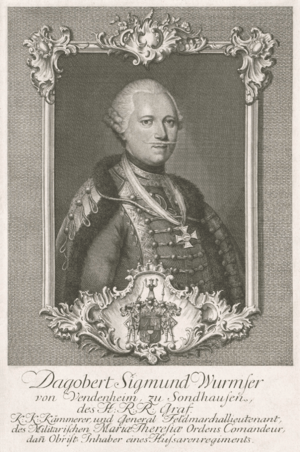Dagobert Sigmund von Wurmser facts for kids
Quick facts for kids
Dagobert Sigmund von Wurmser
|
|
|---|---|
 |
|
| Born | 7 May 1724 Strasbourg, Alsace, Kingdom of France |
| Died | 22 August 1797 (aged 73) Vienna |
| Allegiance | |
| Service/ |
|
| Years of service | 1741–1763 (France) 1763–1796 |
| Rank | Field Marshal |
| Battles/wars | War of the Bavarian Succession
Austro–Turkish War (1787–1791), as Commanding General.
|
| Awards | 1778, Knight's Cross of the Military Order of Maria Theresa 1789, Commander's Cross of the Military Order of Maria Theresa 1793, Grand Cross of the Military order of Maria Theresa |
| Other work | Imperial and Royal Privy Councilor; Imperial and Royal Chamberlain. |
| Signature | |
Dagobert Sigmund, Count von Wurmser (born May 7, 1724 – died August 22, 1797) was an important Austrian military leader, known as a field marshal. He fought in many wars, including the Seven Years' War and the French Revolutionary Wars. He is most remembered for his battles against the famous Napoleon Bonaparte in Italy during 1796.
Wurmser first served in the French Army. After France made peace with Britain, he joined the military of the House of Habsburg, which ruled Austria. He also took part in the short War of the Bavarian Succession, sometimes called the "Potato War." During the French Revolutionary Wars, Wurmser led several Austrian armies in the Rhine River valley. One of his biggest successes was capturing the strong defensive lines of Lauterburg and Weissenburg in October 1793.
In 1796, Francis II, Holy Roman Emperor sent Wurmser to northern Italy. His job was to defend Austria's southern lands from the French army, led by the rising general Napoleon Bonaparte. Wurmser fought bravely, but Napoleon's army was very strong. Wurmser and his army eventually became trapped in the city of Mantua during a long siege. After negotiating, Wurmser was allowed to leave Mantua with his honor and 700 men. He then returned to Vienna. Even though he was defeated at Mantua, the Austrian leaders still respected his service. He was given another important job right away. However, Wurmser was 72 years old and had spent most of his life fighting. His health failed soon after, and he passed away in 1797.
Contents
Early Life and Military Start
Dagobert Wurmser was born in Strasbourg, a city in the French region of Alsace. His father was Frantz Jacob Wurmser von Vendenheim. Dagobert began his military career in the French Army in 1741. He served as a cavalry officer during the early parts of the Silesian Wars. By 1747, he had been promoted to Captain of Cavalry.
In 1750, Wurmser's father moved to Austrian lands and became a subject of the Habsburg rulers. Dagobert followed his father, leaving the French army to join the Austrian military. He even brought the soldiers he commanded from France with him. He fought in the last years of a war sometimes called the "Little War." In these battles against the Prussians, he showed great leadership and courage. On January 30, 1761, Francis I, Holy Roman Emperor made him a Count of the Holy Roman Empire.
The "Potato War"
In the spring of 1778, Wurmser's Hussar soldiers were in northern Bohemia, guarding the border with Saxony and Silesia. This was the start of the War of the Bavarian Succession. A Prussian general, Johann Jakob von Wunsch, crossed into Bohemia. One of Wurmser's captains, Friedrich Joseph, Count of Nauendorf, led 50 Hussars to meet Wunsch's much larger force. Nauendorf tricked the Prussians, and his small group gained the upper hand, forcing Wunsch to retreat. Nauendorf was promoted the next day.
As the war continued, Wurmser's Hussars protected the left side of the main Austrian army. This army was positioned on strong, fortified hills. In October, Joseph II, Holy Roman Emperor moved most of his army back to the Bohemian border. Wurmser was put in charge of a small group of soldiers who stayed behind for the winter. Their job was to stop Prussian attacks.
Wurmser ordered a surprise attack on the village of Dittersbach. His soldiers captured 400 Prussians and eight flags. Because of his successes against the Prussians in 1778, Joseph II gave him the Knight's Cross of the Military Order of Maria Theresa.
In January 1779, Wurmser led another raid into the County of Kladsko. His forces attacked the town of Habelschwerdt. They captured a Prussian general and 714 men, along with cannons and flags. Wurmser's soldiers also attacked another nearby blockhouse. Both Habelschwerdt and the blockhouse were destroyed. Wurmser's patrols reached close to Glatz, covering the Silesian borders.
French Revolutionary Wars
In 1787, Wurmser was promoted to General der Kavallerie. He held several important positions, including commanding general in Galicia during Austria's war with the Ottoman Empire. While Wurmser was fighting in the Balkans, big changes were happening in France. The French Revolution began, leading to calls for a new government.
At first, other European rulers didn't want to get involved. But by 1791, Leopold II, Holy Roman Emperor became worried about his sister, Marie Antoinette, who was the Queen of France. In August 1791, Leopold and the King of Prussia issued the Declaration of Pillnitz. They warned that if anything happened to the French royal family, there would be serious consequences. On April 20, 1792, France declared war on Austria. This began the War of the First Coalition (1792–1797), where France fought against most of its neighbors.
Rhine Campaign (1793–1794)
From February 1793 to January 1794, Wurmser led the Austrian Army of the Rhine. He successfully commanded the attack on the strong Lauterburg and Weissenburg lines on October 13, 1793. These lines were a series of earthworks, or defensive walls made of earth, along the Lauter River. They were a very important defensive position for the French in Alsace-Lorraine.
The French had three battalions and six squadrons of soldiers, with ten cannons, defending these lines. The French defensive line stretched from Lauterbourg on the Rhine to Saarbrücken. The part from Lauterbourg to Wissembourg was protected by the Lines of Wissembourg, which were built almost a century earlier.
On August 20, Wurmser directed an attack on part of the French defenses. His troops successfully pushed the French out of their position. The French general was killed, and some French soldiers were captured. For the next 45 days, Wurmser's forces kept testing the French defenses with small battles. In mid-September, the Prussians won a battle to the north, which encouraged the Austrians and Prussians to plan a major attack.
Wurmser's army had over 33,000 infantry and 9,000 cavalry. They had been fighting the French along the lines for months. While the Prussians moved around the lines, Wurmser organized his army into seven columns. They attacked the lines in waves. In the First Battle of Wissembourg on September 13, Wurmser's forces successfully broke through the French defenses.
Two months later, the French launched a big attack to get the lines back. Wurmser commanded the Austrian soldiers during their defeat at the Second Battle of Wissembourg on December 26, 1793.
Upper Rhine Campaign
From August 1795 to June 1796, Wurmser was in charge of the Army of the Upper Rhine.
Campaign in Northern Italy
In 1796, Wurmser moved his army of 25,000 men from the Rhine to northern Italy. His goal was to join another Austrian army and defend Austria's territories. The two armies met and then marched towards the city of Mantua.
Wurmser's forces had some early successes. An advance group, led by Johann von Klenau, surprised the French soldiers in the city of Brescia. Klenau's troops attacked at midnight, capturing 600–700 French soldiers and three important French officials. Another Austrian group managed to occupy the town of Lonato.
However, Wurmser did not expect the French army to move so quickly. Within two days, Napoleon Bonaparte arrived with 12,000 French soldiers. Klenau's small group was quickly pushed out of Brescia on August 1. At the Battle of Lonato on August 2–3, 1796, the French also forced the other Austrian group to retreat into the mountains. This allowed the French to focus on Wurmser's main army. Napoleon's victory against Wurmser at the Battle of Castiglione forced the old commander to retreat across the Mincio River. This allowed the French to continue their siege of Mantua.
The siege of Mantua was difficult for the French because Napoleon had left his heavy siege equipment behind. By early September, many scattered Austrian units had rejoined Wurmser's army. Even so, at the Battle of Bassano on September 8, the Austrians were outnumbered almost two to one by the French. As the Austrian army retreated, Napoleon ordered a chase. This forced the Austrians to leave behind their cannons and supplies. Many Austrian soldiers were captured, and some units were almost completely destroyed. The Austrians lost 600 killed or wounded, 2,000 captured, and 30 cannons.
Wurmser's army fought its way into the besieged city of Mantua. But they tried to escape suddenly at the Battle of La Favorita on September 15. This was the second attempt to free the fortress. As the Austrians retreated from the battle, they went back into Mantua. From September 15 until February 2, 1797, Wurmser and his army were trapped inside the city while it was under siege.
After the Austrian defeat at the Battle of Rivoli in January 1797, it was clear that no help would come for Mantua. Wurmser sent one of his officers, Johann von Klenau, to discuss surrender terms with French General Jean-Mathieu-Philibert Sérurier. Napoleon himself was present and offered very generous terms. Wurmser, whom Napoleon respected greatly, was allowed to leave Mantua with his men, officers, and his battle honors. He then marched back to Austrian lands.
Legacy
Dagobert Wurmser was considered one of the best field marshals in the Austrian army during the French Revolutionary and Napoleonic Wars. Some historians believe that the Austrian army had problems because its generals were often older, compared to the younger French generals. For example, Wurmser was 72 during the 1796 campaign. However, Wurmser might have been held back more by the Aulic Council (a military council in Vienna) than by his age. Some say the Council sent him a new, inexperienced chief of staff with strict written battle plans. These plans limited his actions in Italy and stopped him from taking advantage of good opportunities.
Wurmser's health failed, and he passed away in Vienna the following summer. He was remembered as a brave and honorable knight.
See also
- Joseph Alvinczy
- Peter Quasdanovich
- Paul Davidovich


